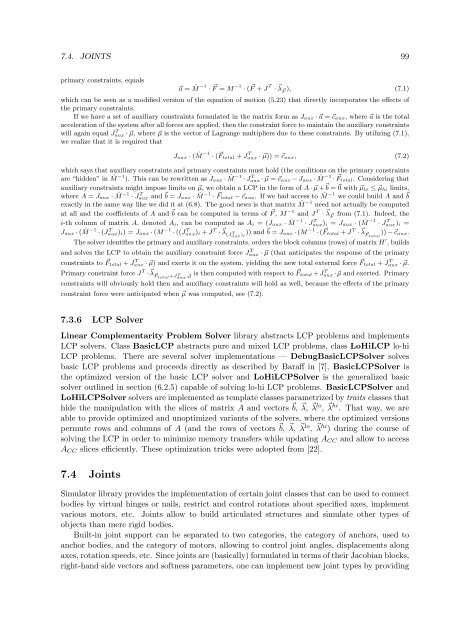thesis - Computer Graphics Group - Charles University - Univerzita ...
thesis - Computer Graphics Group - Charles University - Univerzita ...
thesis - Computer Graphics Group - Charles University - Univerzita ...
Create successful ePaper yourself
Turn your PDF publications into a flip-book with our unique Google optimized e-Paper software.
7.4. JOINTS 99<br />
primary constraints, equals<br />
a = ˆ M −1 · F = M −1 · ( F + J T · λ F ), (7.1)<br />
which can be seen as a modified version of the equation of motion (5.23) that directly incorporates the effects of<br />
the primary constraints.<br />
If we have a set of auxiliary constraints formulated in the matrix form as Jaux · a = caux, where a is the total<br />
acceleration of the system after all forces are applied, then the constraint force to maintain the auxiliary constraints<br />
will again equal J T aux · µ, where µ is the vector of Lagrange multipliers due to these constraints. By utilizing (7.1),<br />
we realize that it is required that<br />
Jaux · ( ˆ M −1 · ( Ftotal + J T aux · µ)) = caux, (7.2)<br />
which says that auxiliary constraints and primary constraints must hold (the conditions on the primary constraints<br />
are “hidden” in ˆ M −1 ). This can be rewritten as Jaux · ˆ M −1 · J T aux · µ = caux − Jaux · ˆ M −1 · Ftotal. Considering that<br />
auxiliary constraints might impose limits on µ, we obtain a LCP in the form of A · µ + b = 0 with µlo ≤ µhi limits,<br />
where A = Jaux · ˆ M −1 · J T aux and b = Jaux · ˆ M −1 · Ftotal − caux. If we had access to ˆ M −1 we could build A and b<br />
exactly in the same way like we did it at (6.8). The good news is that matrix ˆ M −1 need not actually be computed<br />
at all and the coefficients of A and b can be computed in terms of F , M −1 and J T · λ F from (7.1). Indeed, the<br />
i-th column of matrix A, denoted Ai, can be computed as Ai = (Jaux · ˆ M −1 · J T aux)i = Jaux · ( ˆ M −1 · J T aux)i =<br />
Jaux · ( ˆ M −1 · (J T aux)i) = Jaux · (M −1 · ((J T aux)i + J T · λ (J T aux ) i )) and b = Jaux · (M −1 · ( Ftotal + J T · λ Ftotal )) − caux.<br />
The solver identifies the primary and auxiliary constraints, orders the block columns (rows) of matrix H ′ , builds<br />
and solves the LCP to obtain the auxiliary constraint force J T aux · µ (that anticipates the response of the primary<br />
constraints to Ftotal + J T aux · µ) and exerts it on the system, yielding the new total external force Ftotal + J T aux · µ.<br />
Primary constraint force J T · λ Ftotal+J T aux ·µ is then computed with respect to Ftotal +J T aux · µ and exerted. Primary<br />
constraints will obviously hold then and auxiliary constraints will hold as well, because the effects of the primary<br />
constraint force were anticipated when µ was computed, see (7.2).<br />
7.3.6 LCP Solver<br />
Linear Complementarity Problem Solver library abstracts LCP problems and implements<br />
LCP solvers. Class BasicLCP abstracts pure and mixed LCP problems, class LoHiLCP lo-hi<br />
LCP problems. There are several solver implementations — DebugBasicLCPSolver solves<br />
basic LCP problems and proceeds directly as described by Baraff in [7], BasicLCPSolver is<br />
the optimized version of the basic LCP solver and LoHiLCPSolver is the generalized basic<br />
solver outlined in section (6.2.5) capable of solving lo-hi LCP problems. BasicLCPSolver and<br />
LoHiLCPSolver solvers are implemented as template classes parametrized by traits classes that<br />
hide the manipulation with the slices of matrix A and vectors b, λ, λ lo , λ hi . That way, we are<br />
able to provide optimized and unoptimized variants of the solvers, where the optimized versions<br />
permute rows and columns of A (and the rows of vectors b, λ, λ lo , λ hi ) during the course of<br />
solving the LCP in order to minimize memory transfers while updating ACC and allow to access<br />
ACC slices efficiently. These optimization tricks were adopted from [22].<br />
7.4 Joints<br />
Simulator library provides the implementation of certain joint classes that can be used to connect<br />
bodies by virtual hinges or nails, restrict and control rotations about specified axes, implement<br />
various motors, etc. Joints allow to build articulated structures and simulate other types of<br />
objects than mere rigid bodies.<br />
Built-in joint support can be separated to two categories, the category of anchors, used to<br />
anchor bodies, and the category of motors, allowing to control joint angles, displacements along<br />
axes, rotation speeds, etc. Since joints are (basically) formulated in terms of their Jacobian blocks,<br />
right-hand side vectors and softness parameters, one can implement new joint types by providing
















